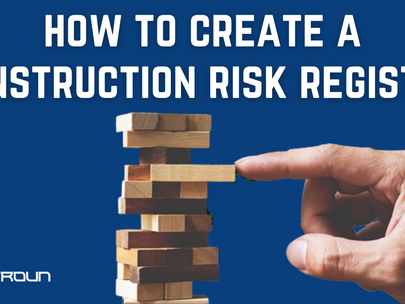Managing risk is a key and vital element of any construction project and the effective reduction of risks tends to directly impact the success of a project both throughout construction and financially. However, managing risk is notoriously complicated and subjective to each project so tools and techniques that could help are always valuable to construction professionals.
One of the most trusted and effective tools that can be used on a construction project is Risk Registers. This blog is going to cover what a risk register is, why you would use one and then what you would include if you were to build a risk register yourself!
Before we jump into risk registers in more detail, we feel it is important to define what risk is within a construction environment. The Royal Institution of Chartered Surveyors defines risk as “an uncertain event or circumstance that, if it occurs, will affect the outcome of a programme/project”.
So, what is a risk register? “A risk register is a risk management tool generally adopted as a central repository for all risks and threats identified. For each threat or risk identified, information in relation to each risk is included, such as a description of the risk, risk consequences, impact rating, risk owner” (RICS) and very often includes further information such as: Risk Categories, Risk Analysis, Risk Probabilities, Risk Response and so on.
Why would you implement a risk register on your project?
By initially identifying and organising risks in this way, it can help project managers, QS’s and other construction professionals to stay on top of potential issues that could derail the desired outcomes of a project. With this being said, it is good practice to start a risk register before a particular project even begins – during the project planning and design stages. In all honesty, there is really no time too early to start thinking of potential risks to your project and logging them in a risk register. This register is then used during the construction phase as a live document throughout, with risks being identified, analysed and reduced on a daily basis.
A project risk register ultimately allows you to collect all potential risks and map out a path to mitigate these risks should they occur. Of course, by identifying and logging potential risks, it may even allow you to remove the risk altogether!
We are now going to show you some simple steps of how to actually produce a simple risk register for a construction project.
1. Risk Identification
First, risks must be identified. Every team member is responsible for different areas of the project, so be sure to gain input from designers through to brick layers and even stakeholders outside of the immediate construction activities! Be sure to exhaust all potential risks from market forces and even the weather.
2. Describe Project Risks
Try to be as thorough as you can while keeping the description to the essentials. Having too little information in the description could make it difficult to truly understand whether a risk has become a real issue or not.
3. Describe Risk Consequences
Here, try to Include all possible consequences, so you can develop a strong and relevant strategy to deal with it, if it becomes reality.
4. Calculate Impact Ratings and Prioritise
Rate the potential impact of each risk on the project. You could do this using High / medium / low or red / amber / green ratings so the level of the potential impact is easily identifiable.
5. Create Risk Responses
This is vital for effective risk management, so give it the time and effort necessary to complete it properly. Keep the risk response plan short and to the point where possible. Do in depth research, so if the risk shows up in the project you can immediately spring into action and start mitigating any impacts.
6. Define Risk Owners
Where you can, assign an owner to each risk. If you don’t have a risk owner for each and every potential risk, then you might not know about it until the impact of that risk is irreversible.
It is important to remember that this is not an exhaustive list of items that could and often are included within a risk register. Additional columns can be added as necessary to satisfy your specific construction projects requirements.






